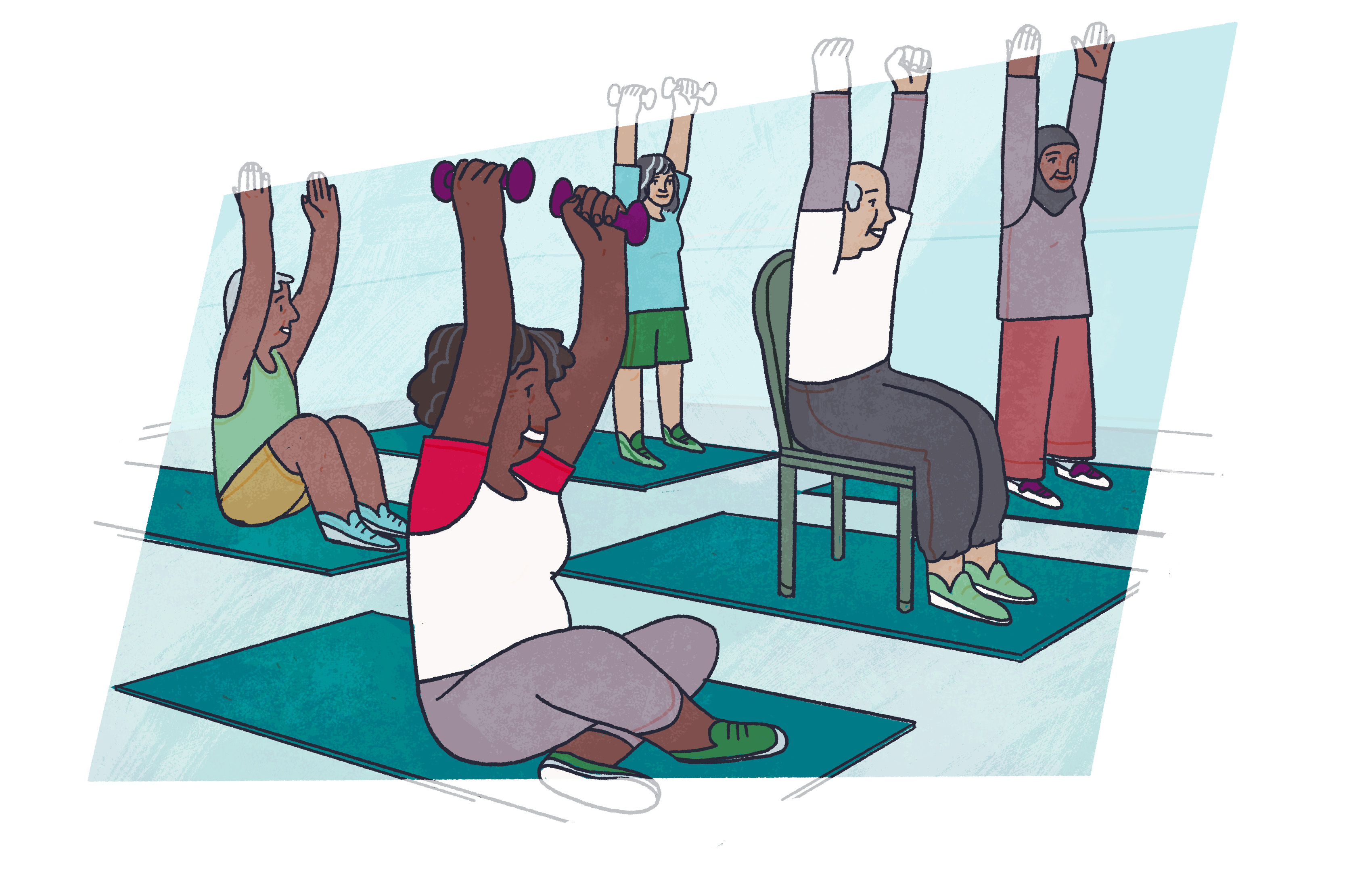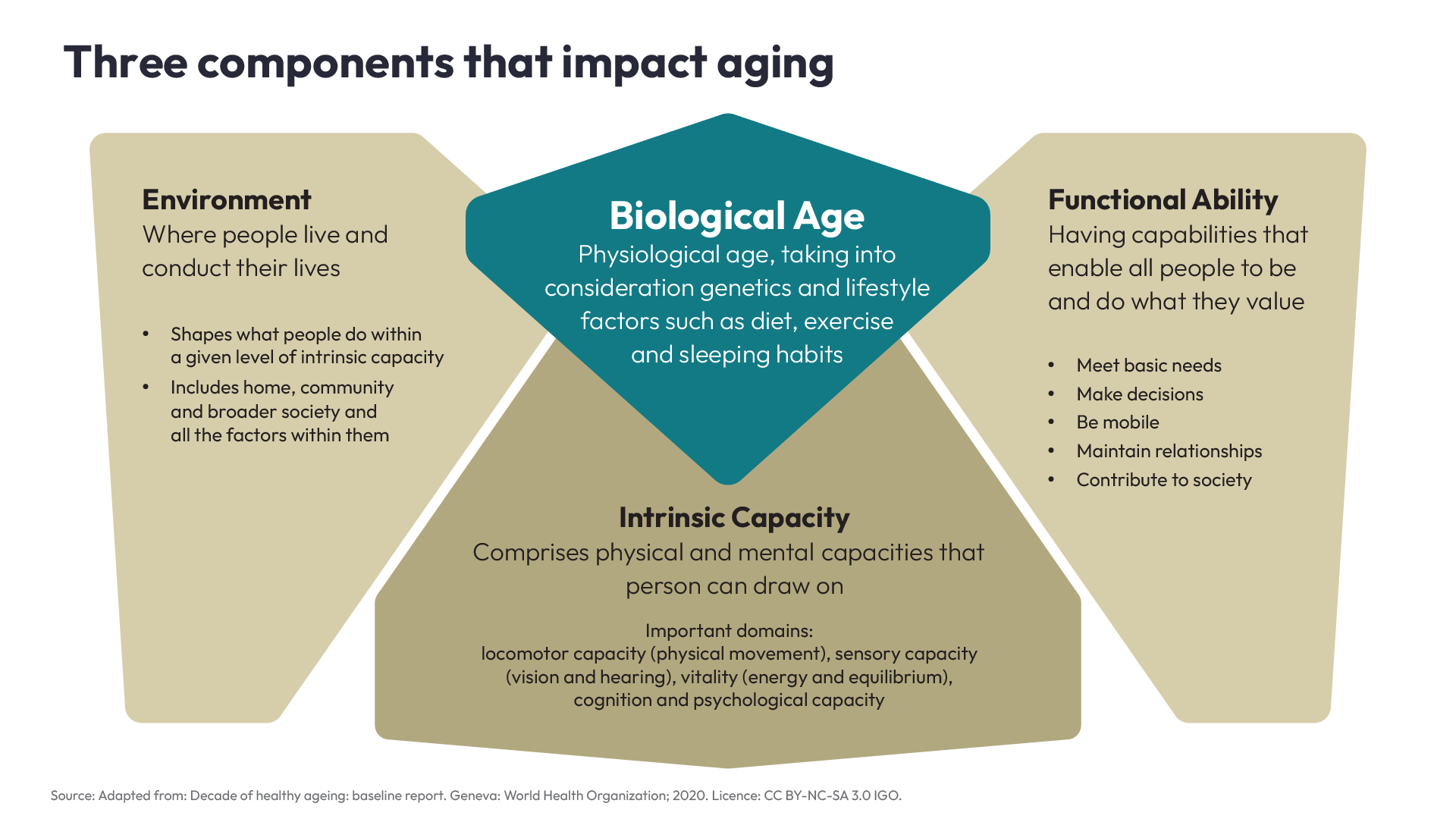CIHR Institute of Aging Strategic Plan 2023-2028
Reframing Aging – Empowering Older Adults
- Introduction and Context
- Strategic Direction A: Implement Prevention Strategies and Promote Health and Wellbeing in Aging
- Strategic Direction B: Adapt Health and Care Systems to Better Address the Needs of Older Adults
- Strategic Direction C: Improve Lived and Living Experiences and Quality of Care in the Later Years
- Cross Cutting Priorities
- Looking Forward
Strategic Direction A: Implement Prevention Strategies and Promote Health and Wellbeing in Aging

We are reframing aging in Canada to envision a future where health span, including quality of life, matches lifespan.
Research Priorities
Foster a better understanding of the heterogeneity of the older adult population and its impact on health
- Define age in terms of functional ability, intrinsic capacity, environment and biological age, rather than chronological age, to develop a more inclusive understanding of aging
Mitigate risk related to the development and progression of chronic conditions
- Support research with a geroscience approach and biological mechanisms of aging
Focus on wellness and quality of life to maintain optimal health and independence
- Support research on social and structural determinants of health across the life course
Priority 1: Foster a better understanding of the heterogeneity of the older adult population and its impact on health
Older adults are active and valuable contributors to society and to their communities and families. Living environments, access to culturally safe health and social care and other opportunities can facilitate healthy aging throughout the life course, enabling people to do what they value throughout their lives, including having an ability to meet basic needs, make decisions and participate. Healthy aging does not necessarily mean being free of disease or infirmity. Many older adults live with one or more chronic conditions that can be controlled and have little influence on their wellbeing. It is critical to consider the health span of older adults and not just their lifespan. Our aim is to extend the health span, so that it lasts as long as the lifespan.
In our goal to reduce and mitigate health risks and to promote healthy aging and wellbeing for older adults, we must consider the heterogeneity of the older population. A definition of age that considers functional ability, intrinsic capacity, environment and biological age can better identify and address the unique needs of an individual than a definition that considers only chronological age. The common expression of 'age being just a number' has long intuited the fact that chronological age, on its own, does not represent the full and unique lived and living experience of an older adult.
This comprehensive approach to defining age aligns with the World Health Organization (WHO) definition of healthy aging, which highlights functional ability as having the capabilities that enable all people to be and do what they value. Intrinsic capacity refers to the mental and physical capacities of an individual, with these being impacted by age-related changes, injury and chronic conditions. Living in an environment that supports and maintains both functional ability and intrinsic capacity is critical for healthy agingFootnote 5. While genetics play a role, aspects of age-related decline in health can be linked to physical and social environment, gender, ethnicity and socioeconomic factors. Supportive environments can reduce barriers and promote opportunities that affect health for people as they age. A person's biological age refers to their physiology and takes into consideration their genetics and lifestyle. Each of these four areas can influence and be influenced by the other three and, together, they help us reframe our understanding of age and aging.

Long Description
Figure 6. Components that impact aging.
Environment
- Where people live and conduct their lives
- Shapes what people do within a given level of intrinsic capacity
- Includes home, community and broader society and all the factors within them
Intrinsic Capacity
- Comprises the physical and mental capacities upon which a person can draw
- Important domains: locomotor capacity (physical movement), sensory capacity (vision and hearing), vitality (energy and equilibrium), cognition and psychological capacity
Functional Ability
- Having capabilities that enable all people to be and do what they value
- Meet basic needs
- Make decisions
- Be mobile
- Maintain relationships
- Contribute to society
Biological Age
- Physiological age, taking into consideration genetics and lifestyle factors such as diet, exercise and sleeping habits
As we continue to uproot entrenched ideas of age and ageism, it is worth stating that age – however it is defined – does not determine a person's value to society.
LOOKING FORWARD
Future research on aging will require improved data on the health status of the increasingly diverse older Canadian population, particularly for marginalized groups, to advance health policy and promote best practices that support healthy aging. This should involve the assessment of functional ability, intrinsic capacity, environment and biological age, rather than stratifying older adults by chronological age, so that services and health care are tailored to the needs of the individual. Strategies that are designed to promote wellness and maintain functional abilities should be assessed for effectiveness and appropriateness to ensure equity for all older adults. This is important for Indigenous health research, particularly in some geographic locations, where healthy foods and health services are not always easily accessible.
Priority 2: Mitigate risk related to the development and progression of chronic conditions
Healthy aging is linked to activities and decisions that impact health across the life course as these can define outcomes during the aging process. Public health strategies that promote prevention approaches and opportunities earlier in life, such as nutrition, physical activity and activities that reduce risk of chronic conditions can have a large impact on overall health and wellness in later years and extend health span in relation to overall life expectancy. While most chronic diseases increase with age, many can be prevented or delayed by implementing healthy behaviours over the years and reducing health inequities and functional decline for vulnerable older adults.
LOOKING FORWARD
Greater alignment is needed across research on aging to better identify the association of aging with risk and management of chronic conditions. Research that advances understanding of the impact of the social and structural determinants of health on aging in diverse populations, from an intersectional and interdisciplinary perspective, should align with research using a geroscience approach and studies on biological mechanisms of aging and senescence. Research on age-related cognitive impairment and dementia that can be linked to and exacerbated by multiple chronic conditions will be supported through the Brain Health and Cognitive Impairment in Aging Research Initiative. The CLSA will also be a critical resource for the research community for investigations in this priority area.
Priority 3: Focus on wellness and quality of life to maintain optimal health and independence
Aging is a life-long process and does not begin in mid-life or the later years. Maintaining optimal health and independence for as long as possible into older age is impacted by life-long health behaviours and social and structural determinants of health across the life course. Determinants for healthy aging can include physical activity, diet, self-awareness, outlook/attitude, life-long learning, faith, social support, financial security, community engagement and independence, and these can vary depending on factors, including culture, age and genderFootnote 6.
The WHO defines social determinants of health as "the non-medical factors that influence health outcomes. They are the conditions in which people are born, grow, live and age, and the wider set of forces shaping the conditions of daily life"Footnote 7. It defines the structural determinants of health as "all social and political mechanisms that generate stratification and social class divisions in society and that define individual socioeconomic position within hierarchies of power, prestige and access to resources"Footnote 8. Inequity in social and structural determinant of health variables, such as economic security, social-connectedness and support, food security and nutrition, education, health care, environment and housing, can have harmful impacts on health throughout life and shape health outcomes in aging if left unaddressed.
LOOKING FORWARD
In our goal to address the opportunities and challenges of aging for older Canadians, we will continue to work closely with the CIHR Institute of Human Development, Child and Youth Health to champion age-inclusive research across CIHR. This will provide an opportunity to include research on the impacts of social and structural determinants of health on aging from a life course perspective. It will also ensure that research is age-appropriate and that older adults and children, youth and families are all fully represented in research concerning their health outcomes. A life course approach in research is critical for promoting health across the lifespan and can stimulate best practices in research so investigations consider all life stages from preconception to older age, and across critical life transitions and generations.
Success and Impact
Within the timeframe of this Strategic Plan, research will contribute to:
- Increased community-based programs that use evidence-informed approaches to promote healthy aging and reduce the risk of development and progression of age-related chronic conditions
- Increased health literacy among Canada's increasing and diverse population of older adults
- Increased understanding of the impact of social and structural determinants of health on aging
- Previous - Introduction and Context
- Next - Strategic Direction B: Adapt Health and Care Systems to Better Address the Needs of Older Adults
- Date modified: